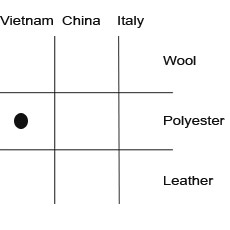Conjoint Analysis is an analytic technique used in marketing that helps managers to determine the relative importance consumers attach to salient product attributes or the utilities the consumers attach to the levels of product or service attributes. Conjoint procedures attempt to assign values to the levels of each attribute so that the resulting utilities attached to the stimuli match as closely as possible. Like MDS, Conjoint Analysis relies on respondents subjective evaluations.
Conjoint Analysis is use for:
- Determining the relative importance of attributes in the consumer choice making process.
- Estimating market share of brands that differ in attribute levels.
- Segmenting the market based on similarity of preferences.
Conjoint Analysis is used for consumer and industrial goods, financial and other services. It is also used for new product development, concept analysis, pricing and market segmentation.
Conducting Conjoint Analysis
Formulating the problem: the researcher must identify the attributes and its levels to be used in constructing the stimuli. The attributes should be salient in influencing consumer choice. For example in the choice of a car the most influential product attributes may be: price, fuel efficiency or interior space. A typical analysis can include six attributes. Once the attributes are selected their appropriate levels should be selected.
Constructing the Stimuli
- Pairwise approach, also called ‘two-factor’.
Respondents evaluate two attributes at a time until all possible pair of attributes have been evaluated. It is not necessary to evaluate all the possible combinations , nor it is feasible.
For example:
Which of of the following product attributes would you choose for your ideal pair of shoes?

In Conjoint Analysis typically the dependent variable is preference or intention to buy.
Deciding on the form of input data:
There can be metric or non-metric data. For non-metric respondents provide rankings. Rankings involve relative evaluations of the attribute levels. In metric data respondents provide ratings.
Conjoint Analysis Models:
The mathematical model expressing the fundamental relationship between attributes and utility in conjoint analysis. Procedures often used in SPSS are:
- Dummy Variable Regression
- MONANOVA
- LOGIT Model
Assessing Reliability and Validity Methods
- The goodness of fit – the value of R-square will indicate the extent to which the model fits the data.
- Test / Re-test – at the later stage of the interview, the respondents are asked to evaluate certain selected stimuli again. The two (earlier and later) values of stimuli are later correlated and assessed for their reliability.
Limitations of Conjoint Analysis
Conjoint Analysis assumes that the important attributes of the product can be identified and this is not always the case. It also assumes that the consumers evaluate the choice alternatives in terms of their attributes and make trade offs. This assumption is invalid when the image associated with a product or its brand are the key decision making factors. In this case all salient product attributes may be irrelevant to the consumer.
